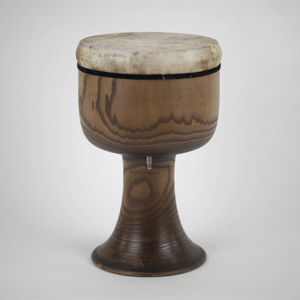The Tombak, also referred to as Zarb, is a wooden goblet drum, which is the most frequently played percussion instrument in Persian folk music and the classical Persian music of Iran. The Tombak is renowned for its distinctive sound and versatility, making it suitable for a wide range of musical styles, from classical to contemporary.
History of the Tombak
The origins of the Tombak date back to ancient Iran, where it was used in religious ceremonies and later became an integral part of classical Persian music. In the early 20th century, the renowned musician Hossein Tehrani standardized Tombak playing techniques and developed a notation system for the instrument.
Characteristics of the Tombak
A unique feature of the Tombak is its ability to produce a wide range of sounds and tones. Players can use various techniques to create different sounds, including open and closed strikes, finger snaps, and slaps. These techniques are used to create the intricate rhythms and melodies that are characteristic of Persian music.
Musical Styles
The Iranian Tombak is used in a variety of musical styles, including classical Persian music, folk music, and contemporary music. In classical Persian music, the Tombak is often played as a solo instrument or as part of an ensemble with other traditional Persian instruments such as the Setar, Tar, and Santur.
In folk music, the Tombak is frequently used to accompany dances and songs. It is played in a variety of regional styles, each with its own unique rhythms and techniques. For example, the Khorasan style of Tombak playing is characterized by fast, intricate rhythms, while the Bushehr style is known for its use of slow, melodic patterns.
In contemporary music, many musicians have used the Tombak to add a unique sound to their compositions. Musicians like Hossein Alizadeh and Mohammad Reza Shajarian have integrated the Tombak into their music, blending traditional Persian styles with modern influences. Whether played in traditional Persian styles or integrated into contemporary music, the Tombak remains a popular instrument that showcases the rich cultural heritage of Iran.
Care and Maintenance of the Tombak
To keep the Tombak in good condition, it is important to keep it clean and free of dust and dirt. It should also be stored in a dry, cool place, away from direct sunlight or extreme temperatures. The Tombak should be tuned regularly, as changes in temperature and humidity can affect its sound and pitch.
The Unique Feature of the Tombak by Majid Drums
**Contrary to the traditional crafting, the Tombak from Majid Drums is made from different, entirely handpicked woods. Since it is not cut out from a single piece of wood, the corpus won’t go out of shape over time.**
Tunable percussion instruments are a great choice for percussionists looking to expand their musical capabilities and explore new sounds and possibilities. In addition, the Tombak of Majid Drums is tunable. An air hose system can be used to change the tension of the skins with a standard bicycle air pump. This form of tuning is both fast and balanced as the air hose directly and evenly spreads the tension to the skin. Heating or moistening of the skin is no longer necessary. This means that the problem of changing the mood with changing air humidity or heat stress is a thing of the past.
This makes it even more interesting to play and listen to, giving the player greater control over the sound and allowing them to achieve the perfect balance and tone.

